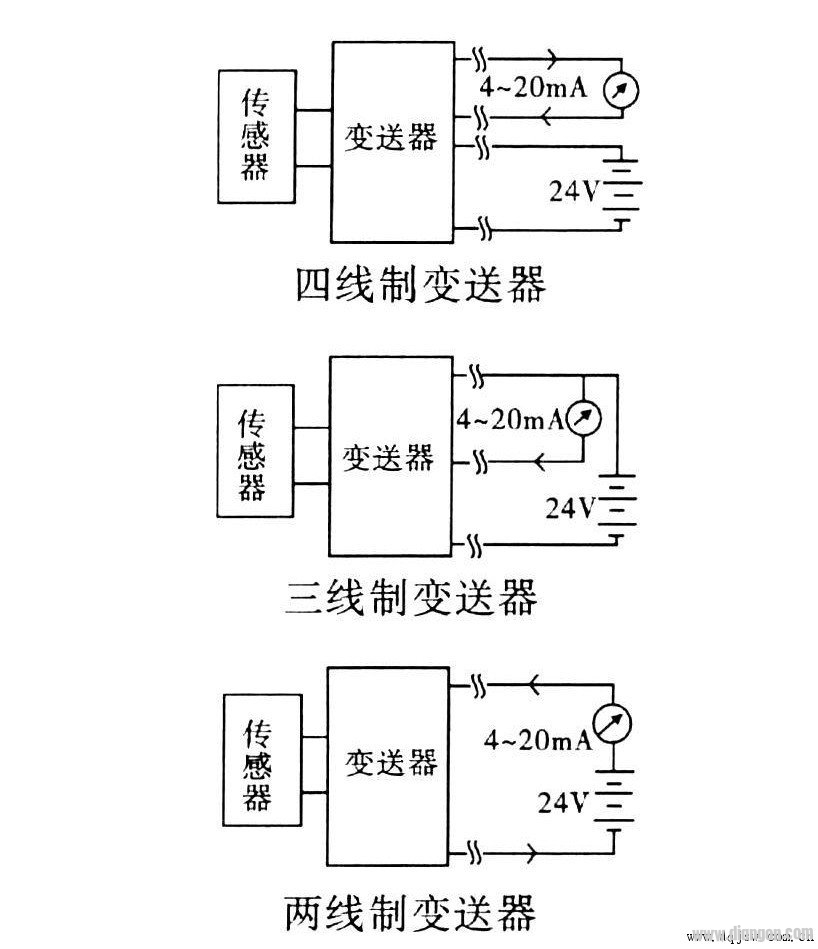Currently, current-output transmitters used in power systems come in four-wire, three-wire, and two-wire signal wiring configurations, as illustrated in the figure. Signal wiring diagram The current-output transmitter converts a physical quantity into a 4–20 mA current output, which requires an external power supply. The most common configuration is a four-wire system, where the transmitter uses two separate lines for power and two for the current output. In a three-wire system, one of the power lines (either VCC or GND) can be shared with the current output, reducing the total number of wires to three. A two-wire transmitter, on the other hand, uses the 4–20 mA current itself to power the device. This means only two wires are needed, making it highly efficient. The industrial standard sets a minimum current of 4 mA, ensuring that the transmitter always has enough power to operate within its range. This design makes two-wire transmitters both practical and reliable. Two-wire transmitters offer several significant advantages: 1) They are less affected by parasitic thermocouples, voltage drops, and temperature drift along the wire. Thin and low-cost wires can be used, significantly reducing cabling and installation costs. 2) When the current source has a high output resistance, magnetic field coupling-induced voltage in the wire loop has minimal impact because the interference current is very small. Twisted pair cables can further reduce this effect. For three-wire systems, shielded cables must be used, and the shielding should be properly grounded. 3) Capacitive interference can cause errors in the receiver’s resistance. In a 4–20 mA two-wire loop, the receiver resistance is typically 250 ohms (producing a voltage output of 1–5V). This low resistance minimizes error, allowing for longer wire lengths compared to voltage-based telemetry systems. 4) Each reading or recording device can switch between different channels with varying wire lengths without affecting accuracy, enabling decentralized data acquisition and centralized control. 5) Using 4 mA as the zero level allows for easy detection of open circuits, short circuits, or sensor failures (when the current drops to 0 mA). 6) It is simple to add surge protection devices at the two-wire output port, enhancing safety against lightning strikes and electrical surges. Compared to three-wire and four-wire transmitters, two-wire systems offer better performance and reliability, and they are gradually replacing older technologies. In the global industry, there's a growing trend toward using two-wire transmitters, especially in applications where the monitoring system is located far from the field equipment—often tens or even hundreds of meters away. These environments are often harsh, with strong electrical signals and potential electromagnetic interference, as well as lightning-induced surges. One of the major challenges in single-chip-based systems is reliably transmitting small signals over long distances in such conditions. Two-wire transmitters have effectively addressed this issue, making them a preferred choice in modern industrial automation and control systems. Inductors serve as indispensable components in electronic circuits, effectively managing current flow and filtering out unwanted frequencies. For low-frequency applications, selecting the appropriate Inductor is crucial for optimal circuit performance. Our extensive range of inductors, meticulously designed for low-frequency filtering tasks. Low Frequency Filter Inductor,Filter Inductor With Base,Round Square Potting Inductor,Inductor Adjustable Inductor Huizhou Show-Grand Electronics Co., Ltd. , https://www.sgtransformer.com
Low-Frequency Filter Inductors: This targeted filtering capability ensures pristine signal integrity in your circuits, minimizing unwanted distortions and ensuring accurate data transmission.These inductors feature exceptional inductance values, specifically tailored to effectively attenuate high-frequency noise while allowing low-frequency signals to pass unhindered.
Filter Inductors with Base: Designed for seamless integration into your project layout, these inductors come equipped with a sturdy base. This base provides a stable mounting platform, simplifying the assembly process and enhancing the overall mechanical stability of your circuit. Whether you're working on a compact PCB design or a larger breadboard prototype, these inductors offer a practical and reliable mounting solution.
Round and Square Potting Inductors: Available in both round and square form factors, these potting inductors provide exceptional protection against environmental factors. enhanced protection makes them ideal for applications where environmental conditions might pose a threat to the inductor's performance or longevity.The potting material encases the inductor core and windings, safeguarding them from moisture, dust, and other contaminants.
Adjustable Inductors: For applications requiring fine-tuned control over inductance values, adjustable inductors offer a unique advantage. These inductors come equipped with a mechanism that allows you to precisely adjust the inductance within a specific range. This adjustability empowers you to optimize circuit performance based on your specific requirements, ensuring your design achieves its full potential.
Encompassing these diverse inductor types, our collection caters to a wide spectrum of low-frequency filtering needs. With their superior performance and versatility, these inductors become instrumental in crafting high-fidelity, low-noise electronic circuits.This range empowers you to select the most suitable inductor for your project, taking into account factors like filtering requirements, mounting preferences, and environmental considerations.